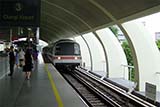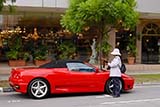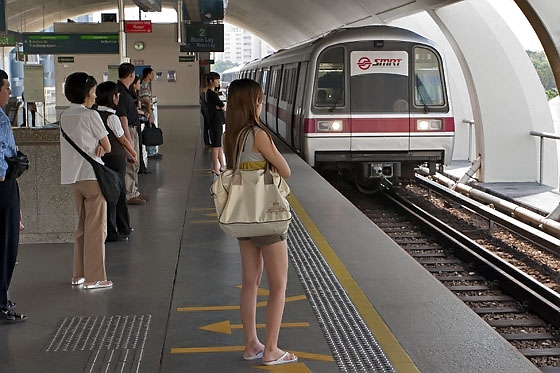Singapore Transport
Introduction
 Getting around in Singapore is a real joy. There is a real integrated transport system, unlike the UK where the various modes of transport are anything but integrated. It would be easy to say that because of Singapore's small size it wasn't difficult building an excellent public transport system but that would be neither an accurate or fair statement. A lot of thought and planning has gone into the system.
Getting around in Singapore is a real joy. There is a real integrated transport system, unlike the UK where the various modes of transport are anything but integrated. It would be easy to say that because of Singapore's small size it wasn't difficult building an excellent public transport system but that would be neither an accurate or fair statement. A lot of thought and planning has gone into the system.
The SMRT (Singapore Mass Rapid Transport) system is a transport wonder of the modern world. It opened in 1990 and has worked like clockwork ever since. The original two lines serve a large part of the island from Changi Airport in the East to Boon Lay and Jurong in the West. On my last visit the new North-East line had opened with useful stops in Chinatown and Little India. This line is the first driverless heavy railway system in the world and the new interchange at Dhoby Ghaut between the North-South line and the Noth-East line is an architectural marvel.
 A new circle line is being added to the system as I write. It hit the news in early 2004 for all the wrong seasons as the tunnelling operation, which was going on a long way underground, caused two highways to collapse. However, when it's finished it will be another welcome addition to the already fabulous system.
A new circle line is being added to the system as I write. It hit the news in early 2004 for all the wrong seasons as the tunnelling operation, which was going on a long way underground, caused two highways to collapse. However, when it's finished it will be another welcome addition to the already fabulous system.
To complement the train system there is a very efficient bus system using modern, double-length, air-conditioned buses. These cover the parts of Singapore that are not covered by the SMRT and the bus routes have been designed and coordinated with the SMRT in mind thereby making it a truly integrated system. What's more, the same card readers are used on the buses and trains making it extremely convenient to pay for fares with one card when using buses and trains.
If it is more convenient to take a taxi than to use public transport that is never a problem. There are thousands of clean, safe and carefully regulated taxis. They are all metered so there is never the problem of being ripped off as happens in so many other cities. They are cheap too. Taxis in Singapore are a viable means of transport to most people in Singapore unlike in London where the extremely high cost makes them almost a luxury item.
 Taxis can be hailed from the street or found at one of the many organised taxi ranks. They can also be ordered by phone and the bidding system used by the taxi companies is very efficient. Requested fares are transmitted to all drivers and appear on a small display next to the driver. Drivers are not allocated work but cab bid for work they want. What this means is that the driver who bids for that fare is probably the one who is nearest at the time and this normally results in taxis that were ordered arriving very quickly.
Taxis can be hailed from the street or found at one of the many organised taxi ranks. They can also be ordered by phone and the bidding system used by the taxi companies is very efficient. Requested fares are transmitted to all drivers and appear on a small display next to the driver. Drivers are not allocated work but cab bid for work they want. What this means is that the driver who bids for that fare is probably the one who is nearest at the time and this normally results in taxis that were ordered arriving very quickly.
Despite having a wonderful public transport system, Singaporeans still insist on owning cars. The government has made car ownership very expensive to try to limit the number of vehicles on the roads but this hasn't stopped many Singaporeans buying cars. Before someone can buy a car they first have to acquire a Certificate of Entitlement (CoE) which is quite expensive. There are very high taxes in Singapore for vehicles so average family cars that cost relatively little in other countries are very expensive. On top of this there are Electronic Road Pricing (ERP) charges to enter certain parts of the city by road.
I admit that sometimes it is more convenient to have your own car but I know from experience that surviving in Singapore without a car is quite possible. This isn't small town America where there aren't any alternatives to a car. As I've pointed out above there are all sorts of public transportation options.
So what is this fascination with the car? Unfortunately, Asians (the Chinese in particular) are extremely status conscious and the car is the ultimate status symbol. This is why some Singaporeans (and indeed other people I've met from Asian countries) will choose to compromise on housing and use the money for that ultimate symbol of having made it in the modern world - the motorcar.
There is no other reason to account for the all the German and Japanese luxury cars and Italian sports cars on the roads of Singapore.
Oh, and the picture of the trishaw above? Not so many years ago, before Singapore's meteoric rise from third to first world, this was a common way of getting around. Now they are just for the tourists. Some of the old Chinese gents peddling around are over 60 but still going strong and their vehicles too are often quite old. Rides can be fun but make sure you negotiate a price first.
My first experience in one, when I took a ride with my brother, resulted in a 15 minute ride and a bill for 50 SGD because we didn't negotiate a fare first. The gent pictured above gave me a 20 minute ride for 10 SGD. His little trick was to aim for groups of girls walking around during their lunch breaks and make out he was going to crash into them before swerving away. He'd probably been doing that for 40 years.
Get The Best Deal On Your Singapore Hotel Room
Listed opposite are some suggestions for hotels in Singapore based on budget. Each link will take you to the relevant page on the Agoda website where you can see photos, read reviews, and book on-line. I use Agoda to book all of my own hotels in Thailand and the Southeast Asia region. Agoda hotel rates are usually always the lowest and I have received good customer service, therefore I am happy to recommend the company to other people.

Images of Thailand
Top End
Mid Range
Chinatown
Budget Hotels
Backpacker Accommodation

